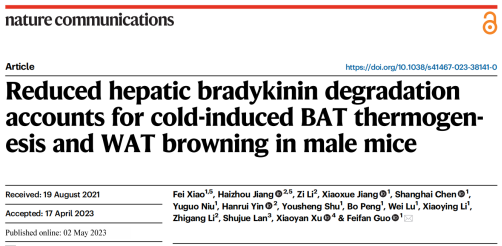On May 2, 2023, a research team led by Professor Feifan Guo from our institute published a research paper entitled “Reduced hepatic bradykinin degradation accounts for cold-induced BAT thermogenesis and WAT browning in male mice” in the international academic journal Nature Communications. This study found that serum bradykinin levels in mice significantly increase during acute cold exposure.
Utilizing multiple primary cell models and tissue-specific knockout mice, the authors discovered that bradykinin (BK) possesses a novel function: promoting thermogenesis in brown adipose tissue (BAT) and the browning of white adipose tissue (WAT). This work deepens our understanding of bradykinin’s physiological functions and the body’s cold adaptation process, potentially providing new targets for the clinical prevention and treatment of metabolic diseases such as obesity.

Imbalances in systemic energy metabolism homeostasis can lead to various chronic metabolic diseases, including obesity. Adipose tissue comprises brown adipose tissue (BAT) and white adipose tissue (WAT). BAT is a thermogenic tissue. Under certain stimuli, cells functionally similar to brown adipocytes (termed beige adipocytes) can emerge within WAT, a process known as WAT browning. Enhancing BAT thermogenesis and WAT browning increases energy expenditure and reduces fat deposition, making them potential strategies against obesity.
Bradykinin, a nine-amino acid peptide known for its vasodilatory and blood pressure-lowering effects, is a key component of the kallikrein-kinin system (KKS). As early as 1979, researchers observed that circulating bradykinin levels in humans significantly increase with decreasing body temperature. However, the physiological significance of this phenomenon and bradykinin's regulatory role in adipose tissue metabolism remained unclear. In this study, the authors first confirmed that serum bradykinin levels markedly rise in mice during acute cold exposure (4°C). Mice injected with a bradykinin-neutralizing antibody exhibited a faster drop in body temperature upon cold exposure compared to controls. Further studies demonstrated that intraperitoneal injection of bradykinin into wild-type mice increased body temperature, enhanced oxygen consumption rate in BAT, and upregulated the expression of uncoupling protein 1 (UCP1). UCP1 uncouples ATP synthesis from oxidative phosphorylation, releasing stored chemical energy as heat. Additionally, bradykinin treatment induced WAT browning: lipid droplets in WAT became smaller, the expression of multiple browning marker genes (including UCP1) increased, and oxygen consumption rates rose. Similar effects were observed in primary brown and white adipocytes treated with bradykinin.
The known mechanism of bradykinin action involves binding to its receptor, the bradykinin B2 receptor (B2R). Using the specific B2R inhibitor icatibant and adipose tissue-specific B2R knockout mice, the authors demonstrated that bradykinin regulates UCP1 expression, BAT thermogenesis, and WAT browning via B2R. To further elucidate the underlying mechanisms, the team performed RNA sequencing (RNA-seq) on the BAT of wild-type mice injected with bradykinin. KEGG pathway enrichment analysis revealed significant enrichment in the adrenergic signaling pathway. Employing β-adrenergic receptor blockers, the authors identified this pathway as mediating the rapid effects of bradykinin on BAT UCP1 expression and body temperature. Subsequent studies showed that the nitric oxide (NO) signaling pathway also contributes to bradykinin's regulation of UCP1 expression.
The team then investigated the mechanism and significance of increased serum bradykinin during acute cold exposure. Results indicated that elevated liver fatty acid content during cold stress inhibits hepatic prolyl endopeptidase (PREP) activity. Reduced PREP activity decreases bradykinin degradation, thereby increasing serum bradykinin levels. Finally, exploring the potential of bradykinin as an anti-obesity target, the authors found that angiotensin-converting enzyme inhibitors (ACEIs) increase endogenous bradykinin levels by inhibiting ACE, thereby promoting BAT thermogenesis and WAT browning – a process dependent on adipose tissue B2R.
In summary, this work reveals a crucial role for bradykinin in the body's adaptation to cold stress. Bradykinin enhances UCP1 expression, promotes BAT thermogenesis, and induces WAT browning. These functions depend on B2R, the adrenergic signaling pathway, and the NO signaling pathway (Figure 1). This study expands our understanding of how inter-organ communication regulates systemic metabolic homeostasis and provides a theoretical foundation for future screening of clinical interventions targeting the bradykinin pathway.
Dr. Fei Xiao (Institute for Translational Brain Research / Zhongshan Hospital, Fudan University) and Haizhou Jiang (Ph.D. candidate, Shanghai Institute of Nutrition and Health, Chinese Academy of Sciences) are co-first authors of the paper. Professor Feifan Guo (Institute for Translational Brain Research / Zhongshan Hospital, Fudan University) is the corresponding author. This research was supported by grants from the National Natural Science Foundation of China and the National Key R&D Program of China.

paper link: https://www.nature.com/articles/s41467-023-38141-0